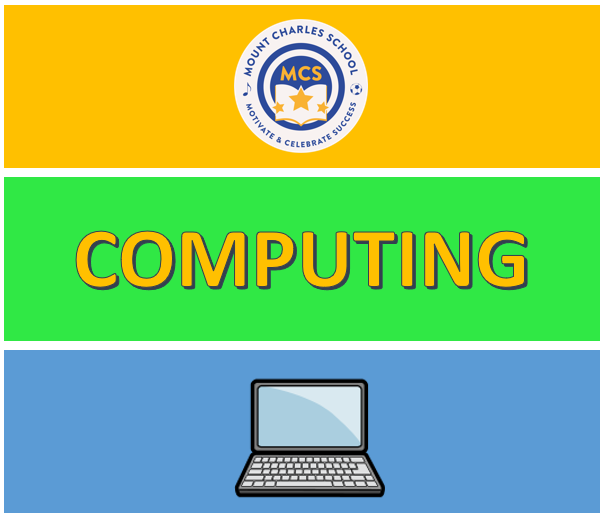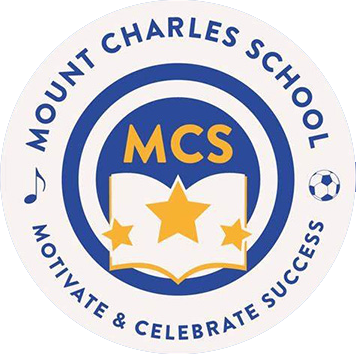
Computing

INTENT
At Mount Charles School, we believe that it is our responsibility to provide all children, including disadvantaged pupils and pupils with SEND, with the skills and knowledge to manage an ever-changing and increasingly technological world. A high-quality computing education equips pupils to use computational thinking and creativity to understand and change the world. We believe that technology can provide: enhanced collaborative learning opportunities; better engagement of pupils; easier access to rich content; support conceptual understanding of new concepts and can support the needs of all our pupils.
We aim to provide pupils with an ability to:
- understand how to navigate and use the Internet safely and responsibly;
- understand and apply the fundamental principles and concepts of computer science, including abstraction, logic, algorithms and data representation;
- analyse problems in computational terms, and have repeated practical experience of writing computer programs in order to solve such problems;
- evaluate and apply information technology, including new or unfamiliar technologies, analytically to solve problems.
Computing is composed of three main strands which underpin children’s understanding of the computing curriculum. These are:
- Computer Science: the core of computing; pupils are taught the principles of information and computation, how digital systems work, and how to put this knowledge to use through programming.
- Digital Literacy: ensuring pupils are able to express themselves and use technology at a level suitable for their future workplace. Pupils understand the online world and know how to navigate this safely and with appropriate behaviour.
- Information Technology: pupils are equipped with the ability to use technology to purposefully create, organise and develop work using a range of programs and software. Pupils will be able to collect, analyse and evaluate data collected and present this in a range of ways.
We firmly believe the importance of delivering a high quality, online safety curriculum to prepare our pupils for the wider world and future workplace. This is embedded throughout the computing curriculum in Purple Mash, as well as being taught explicitly in Autumn 1 in our Online Safety units and in PSHE sessions through our Jigsaw curriculum.
As technology develops, so does the need for a better understanding of how to use it in a responsible manner. The education of online safety is therefore essential, to ensure pupils are equipped with the skills to recognise risks online, to be critically aware of the materials and content they access online, along with guidance on how to accurately validate information accessed via the internet.
IMPLEMENTATION
The delivery of computing and online safety is planned in line with the National Curriculum and allows for clear progression as pupils move through each stage of their education with us. Teachers use the ‘Purple Mash’ scheme of learning and online platform, to support their planning and delivery of the computing curriculum from Years 1-6. In EYFS, the MiniMash area of Purple Mash is used to provide our pupils with a broad, play-based experience of Computing in a range of contexts. The Purple Mash scheme of work and range of units ensure pupils have regular opportunities to build their skills and knowledge of computing throughout their primary school experience. This ensures pupils build strong knowledge in the three key computing strands of learning: computer science, digital literacy and information technology. Within these strands, there are three key units that are taught in every year group from Years 1-6, these are: coding, online safety and spreadsheets. This ensures pupils build up a strong understanding of each of these three units and have regular opportunities to reflect and build on what they know throughout their primary school experience.
Computing lessons ensure pupils have plenty of opportunities to apply their computing knowledge using the Purple Mash platform, through guided activities and independent creation. It also instils critical thinking, reflective learning and a ‘can do’ attitude for all of our pupils, particularly when engaging with technology and its associated resources.
Online safety is regularly referred to throughout each unit taught using the ‘Purple Mash’ scheme, in addition to some discrete units taught throughout the year. We use other resources such as the ‘SMART crew’ to support our teaching and to ensure we keep up with new issues and development. At Mount Charles School, we strive to engage parents and carers with the importance of safe and responsible behaviour online, providing support through sharing tips from the National Online Safety Organisation (NOS) through our social media and newsletters. Annually, pupils also take part in ‘Safer Internet Day’, following the yearly theme which reflects current issues. This ensures pupils have opportunity to discuss their thoughts about how to use the Internet safely and how to behave appropriately online.
We recognise the need to continually maintain, update and develop resources to ensure the effective delivery of the National Curriculum and support the use of technology throughout the school. This includes:
- Interactive whiteboards in every classroom to enhance and promote effective use of technology for learning.
- Teacher iPads in each classroom to be able to support teaching and learning using SeeSaw or Tapestry to record practical learning.
- 15 Surface Go devices per year group in Years 4, 5 and 6 for pupil use within lessons.
- 15 iPads per year group in Years 1, 2, 3 and EYFS for pupil use within lessons.
- A range of programmable devices including Beebots.
- Subscription to online content to promote learning in school and to support homework, these include: Boom Reader, Spelling Shed, TT Rockstars, Purple Mash and eSchools.
In Key Stage One, pupils will:
- Understand what algorithms are, how they are implemented as programs on digital devices, and that programs execute by following a sequence of instructions.
- Write and test simple programs.
- Organise, store, manipulate and retrieve data in a range of digital formats.
- Communicate safely and respectfully online, keeping personal information private, and recognise common uses of information technology beyond school.
In Key Stage Two, pupils will:
- design and write programs that accomplish specific goals, including controlling or simulating physical systems - solving problems by decomposing them into smaller parts;
- use sequence, selection and repetition in programs, work with variables and various forms of input and output, generate appropriate inputs and predicted outputs to test programs;
- use logical reasoning to explain how a simple algorithm works and to detect and correct errors in algorithms and programs;
- understand computer networks including the Internet, how they can provide multiple services such as the world-wide web and the opportunities they offer for communication and collaboration;
- describe how internet search engines find and store data, use search engines effectively, be discerning in evaluating digital content, respect individuals and intellectual property, use technology responsibly, securely and safely;
- select, use and combine a variety of software (including internet services) on a range of digital devices to accomplish given goals, including collecting, analysing, evaluating and presenting data and information.
IMPACT
In 2022, 87% of Year 6 pupils met the expected standard at the end of Key Stage 2.
Subject Leader monitoring has shown:
- lessons are planned to meet the needs of all learners including those with SEND and who are disadvantaged;
- pupils talk with passion about computing;
- pupils of all abilities feel success in computing lessons;
- pupils are exposed to a range of software and resources to develop their understanding of the three key strands of computing;
- pupils are completing work in Purple Mash, through the setting of 2Do’s, linked to the provided learning objective and success criteria;
- teachers are secure in their subject knowledge;
- evidence of cross-curricular links in work, particularly with maths in spreadsheet units and design and technology through computer aided-design.
Impact of Computing at Mount Charles School is carefully tracked and measured by…
- Monitoring of pupils’ work on Purple Mash, on SeeSaw and in Gold Books.
- Learning walks to monitor quality of teaching and learning in computing.
- Discussion with pupils to ascertain engagement in computing.
- Monitoring of short-term planning to ensure all areas of the national curriculum are covered and matched with the focus unit being taught.
- Triangulation of learning walks, book looks, Purple Mash work analysis, planning and pupil discussion to obtain a reliable overall picture of the quality of teaching and learning in computing.
- Tracking of assessment of lessons taught on Purple Mash, through teacher assessment and data produced.
- Summative assessment tracking each half term on the whole school online assessment tracker, Insight.
Pupils leave Mount Charles confident in using technology to complete a range of tasks and equipped with the skills needed to develop their understanding of computing throughout secondary school. Integral to these outcomes for pupils are:
- an understanding of what a digital footprint is and how all online activity we engage in, contributes to this. They will understand how this can affect their lives in the future and how to use the internet safely and responsibly;
- Knowing that technology can be used in a range of ways to support and complete tasks in the modern world;
- being digitally literate at a level suitable for a future workplace and being able to express themselves and use information technology to develop their ideas.




